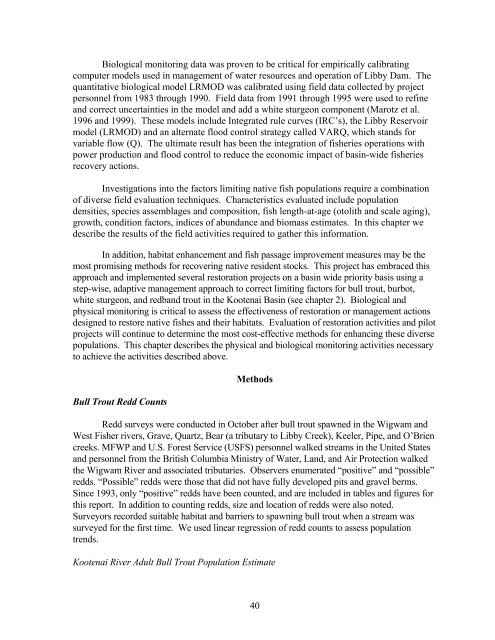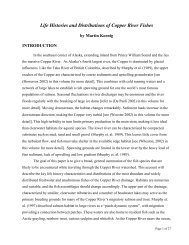Mitigation for the Construction and Operation of Libby Dam
Mitigation for the Construction and Operation of Libby Dam
Mitigation for the Construction and Operation of Libby Dam
You also want an ePaper? Increase the reach of your titles
YUMPU automatically turns print PDFs into web optimized ePapers that Google loves.
Biological monitoring data was proven to be critical <strong>for</strong> empirically calibrating<br />
computer models used in management <strong>of</strong> water resources <strong>and</strong> operation <strong>of</strong> <strong>Libby</strong> <strong>Dam</strong>. The<br />
quantitative biological model LRMOD was calibrated using field data collected by project<br />
personnel from 1983 through 1990. Field data from 1991 through 1995 were used to refine<br />
<strong>and</strong> correct uncertainties in <strong>the</strong> model <strong>and</strong> add a white sturgeon component (Marotz et al.<br />
1996 <strong>and</strong> 1999). These models include Integrated rule curves (IRC’s), <strong>the</strong> <strong>Libby</strong> Reservoir<br />
model (LRMOD) <strong>and</strong> an alternate flood control strategy called VARQ, which st<strong>and</strong>s <strong>for</strong><br />
variable flow (Q). The ultimate result has been <strong>the</strong> integration <strong>of</strong> fisheries operations with<br />
power production <strong>and</strong> flood control to reduce <strong>the</strong> economic impact <strong>of</strong> basin-wide fisheries<br />
recovery actions.<br />
Investigations into <strong>the</strong> factors limiting native fish populations require a combination<br />
<strong>of</strong> diverse field evaluation techniques. Characteristics evaluated include population<br />
densities, species assemblages <strong>and</strong> composition, fish length-at-age (otolith <strong>and</strong> scale aging),<br />
growth, condition factors, indices <strong>of</strong> abundance <strong>and</strong> biomass estimates. In this chapter we<br />
describe <strong>the</strong> results <strong>of</strong> <strong>the</strong> field activities required to ga<strong>the</strong>r this in<strong>for</strong>mation.<br />
In addition, habitat enhancement <strong>and</strong> fish passage improvement measures may be <strong>the</strong><br />
most promising methods <strong>for</strong> recovering native resident stocks. This project has embraced this<br />
approach <strong>and</strong> implemented several restoration projects on a basin wide priority basis using a<br />
step-wise, adaptive management approach to correct limiting factors <strong>for</strong> bull trout, burbot,<br />
white sturgeon, <strong>and</strong> redb<strong>and</strong> trout in <strong>the</strong> Kootenai Basin (see chapter 2). Biological <strong>and</strong><br />
physical monitoring is critical to assess <strong>the</strong> effectiveness <strong>of</strong> restoration or management actions<br />
designed to restore native fishes <strong>and</strong> <strong>the</strong>ir habitats. Evaluation <strong>of</strong> restoration activities <strong>and</strong> pilot<br />
projects will continue to determine <strong>the</strong> most cost-effective methods <strong>for</strong> enhancing <strong>the</strong>se diverse<br />
populations. This chapter describes <strong>the</strong> physical <strong>and</strong> biological monitoring activities necessary<br />
to achieve <strong>the</strong> activities described above.<br />
Bull Trout Redd Counts<br />
Methods<br />
Redd surveys were conducted in October after bull trout spawned in <strong>the</strong> Wigwam <strong>and</strong><br />
West Fisher rivers, Grave, Quartz, Bear (a tributary to <strong>Libby</strong> Creek), Keeler, Pipe, <strong>and</strong> O’Brien<br />
creeks. MFWP <strong>and</strong> U.S. Forest Service (USFS) personnel walked streams in <strong>the</strong> United States<br />
<strong>and</strong> personnel from <strong>the</strong> British Columbia Ministry <strong>of</strong> Water, L<strong>and</strong>, <strong>and</strong> Air Protection walked<br />
<strong>the</strong> Wigwam River <strong>and</strong> associated tributaries. Observers enumerated “positive” <strong>and</strong> “possible”<br />
redds. “Possible” redds were those that did not have fully developed pits <strong>and</strong> gravel berms.<br />
Since 1993, only “positive” redds have been counted, <strong>and</strong> are included in tables <strong>and</strong> figures <strong>for</strong><br />
this report. In addition to counting redds, size <strong>and</strong> location <strong>of</strong> redds were also noted.<br />
Surveyors recorded suitable habitat <strong>and</strong> barriers to spawning bull trout when a stream was<br />
surveyed <strong>for</strong> <strong>the</strong> first time. We used linear regression <strong>of</strong> redd counts to assess population<br />
trends.<br />
Kootenai River Adult Bull Trout Population Estimate<br />
40
















